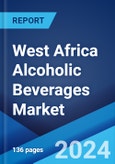The Rising Middle-Class Population is Augmenting the Market Growth
Africa, the second-largest continent in the world, is emerging as one of the fastest-growing economies globally. The region's economy has been on an upward trajectory, with several West African countries exhibiting impressive annual GDP growth rates. This growth rate is much higher than that of many other developing countries worldwide. As a result, the middle-class population in the region is growing, with consumers having more disposable income levels. Thus, increasing purchasing power causes a shift in spending patterns, with media and other influencing factors playing a significant role in shaping consumer behavior. As consumers in the region continue to enjoy higher levels of disposable income, their preferences have shifted towards non-essential and recreational products. This trend is benefiting the overall alcoholic beverages industry and can be attributed to the rising demand for leisure and recreational activities among the middle-class population in West Africa.Competitive analysis such as market structure, market share by key players, player positioning, top winning strategies, competitive dashboard, and company evaluation quadrant has been covered in the report. Also, detailed profiles of all major companies have been provided. The market structure is concentrated with only three major players operating in the market due to a moderate growth rate. The volume of new entrants is moderate in the West Africa alcoholic beverages industry due to high brand development and marketing cost.
- What are Alcoholic Beverages?
COVID-19 Impact:
The COVID-19 pandemic had a significant impact on the alcoholic beverages industry in West Africa. With the implementation of lockdowns and social distancing measures across the region, there has been a temporary closure of bars, nightclubs, and other social venues, leading to a sharp decline in the consumption of alcoholic beverages. This decline in demand led to a significant reduction in sales for many companies operating in the alcoholic beverages industry. The COVID-19 pandemic also affected the production and distribution of alcoholic beverages in West Africa due to the closure of borders and restrictions on the movement of goods, which makes it difficult for companies to access raw materials and transport their products to their intended destinations. As a result, many companies had to scale back their production or temporarily shut down their operations.West Africa Alcoholic Beverages Market Trends:
The increasing consumption of alcoholic beverages among the masses majorly drives the market in West Africa. This can be supported by the growing demand for certain types of alcoholic beverages, such as craft beer, premium wine, and high-end spirits, due to the changing consumer preferences for unique and high-quality products. In addition, the rising popularity of socializing and attending mid-week and weekend parties among young adults and working professionals is positively influencing the market. With the shifting trend towards urbanization is resulting in the introduction of premium beverages that are associated with sophistication, is providing a boost to the sales of alcoholic beverages across the region. In addition, the growing preference for experimenting with a range of flavored alcohols and mixed beverages is also driving the market. Furthermore, continual technological advancements, such as the emergence of automation, data analytics, and e-commerce, are creating a positive market outlook for leading companies to determine the market trend and enhance production and distribution efficiency, are significantly supporting the demand. Some of the other factors driving the market include rapid urbanization and inflating disposable income levels of the masses.Key Market Segmentation:
The publisher provides an analysis of the key trends in each segment of the West Africa alcoholic beverages market report, along with forecasts at the regional and country levels from 2024-2032. The report has categorized the market based on product type, packaging type and distribution channel.Product Type Insights:
- Beer
- Spirits
- Wine
- Others
Packaging Type Insights:
- Glass Bottles
- Tins
- Plastic Bottles
- Others
Distribution Channel Insights:
- Open Markets
- Supermarkets/Hypermarkets
- Hotels/Restaurants/Bars
- Specialty Stores
- Others
Regional Insights:
- Nigeria
- Ghana
- Cote de Ivorie
- Cameroon
- Senegal
- Others
Competitive Landscape:
The report has also provided a comprehensive analysis of the competitive landscape in the West Africa alcoholic beverages market. Some of the companies covered in the report include:
- Diageo Plc
- Heineken International B.V
- Anheuser-Busch InBev
- Castel Group
- Kasapreko Company Ltd
- Tambour Original
Key Questions Answered in This Report
1. What was the size of the West Africa alcoholic beverages market in 2023?2. What is the expected growth rate of the West Africa alcoholic beverages market during 2024-2032?
3. What are the key factors driving the West Africa alcoholic beverages market?
4. What has been the impact of COVID-19 on the West Africa alcoholic beverages market?
5. What is the breakup of the West Africa alcoholic beverages market based on the product type?
6. What is the breakup of the West Africa alcoholic beverages market based on the packaging type?
7. What is the breakup of the West Africa alcoholic beverages market based on the distribution channel?
8. What are the key regions in the West Africa alcoholic beverages market?
9. Who are the key players/companies in the West Africa alcoholic beverages market?
Table of Contents
Companies Mentioned
- Diageo Plc
- Heineken International B.V.
- Anheuser-Busch InBev
- Castel Group
- Kasapreko Company Ltd
- Tambour Original
Methodology

LOADING...
Table Information
| Report Attribute | Details |
|---|---|
| No. of Pages | 136 |
| Published | March 2024 |
| Forecast Period | 2023 - 2032 |
| Estimated Market Value ( USD | $ 13.2 Billion |
| Forecasted Market Value ( USD | $ 21.8 Billion |
| Compound Annual Growth Rate | 5.7% |
| Regions Covered | Africa |
| No. of Companies Mentioned | 6 |









